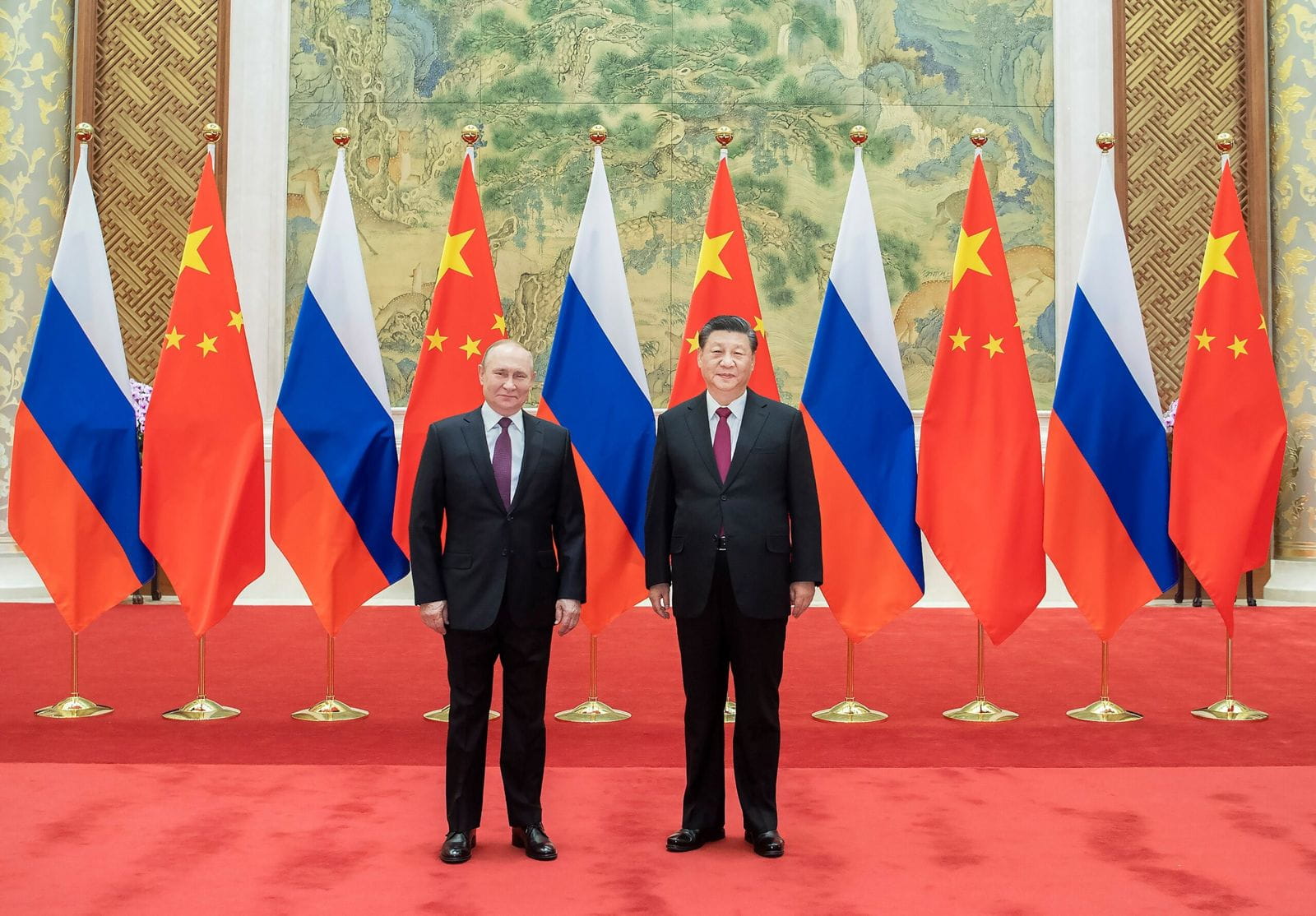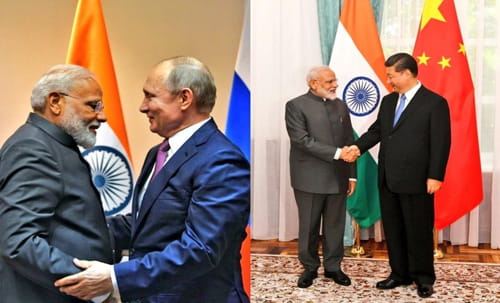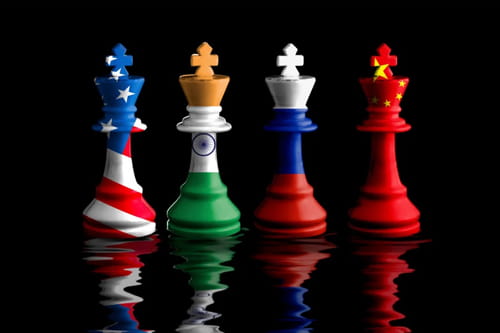
Chinese President Xi Jinping (left) with Russian President Vladimir Putin.
The West is still to devise a serious plan of action to deal with China’s grey-zone tactics while Russia has been heavily sanctioned for its invasion of Ukraine. The American policy to deal with the Sino-Soviet alliance during the Cold War was to India’s detriment as it decided to strengthen India’s main strategic challenge, China against the Soviets. Even in the contemporary context, the US is driving Russia in China’s arms by clubbing them together. This again has negative implications for India.
Introduction
Russia’s relationship with China has been one of the important factors shaping the contours of global and Eurasian geopolitics. This relationship has been particularly important for India, as the nature of Russia-China ties plays a critical role in India’s foreign and national security choices. The West led by the US seems to be locked in an indirect mortal combat with Russia through the Ukraine war. The ever increasing Western sanctions on Russia have forced Moscow to be economically and diplomatically dependent on China against the West.
India has a close strategic partnership with the US in order to balance their common security concern, China; however, New Delhi has been absorbing Western pressure to isolate Russia as it continues to engage with Moscow in order to slow down the pace of Russia’s strategic China embrace. There is considerable diversity of opinion among strategic experts, most of whom believe Russia-China relationship is not a military alliance.
However, the American National Security Strategy released in October 2022 under the current Biden administration argues that Russia is an ‘immediate security challenge’ for the US while China is a ‘long term’ security concern. The previous version, released in 2017 under President Donald Trump had clubbed both Russia and China as ‘revisionist powers’ that want to shape a world that is antithetical to US values and interests.
Similarly, the NATO Vilnius Summit Communiqué in 2023 had identified Russia as the most significant and direct threat to peace and stability in the Euro-Atlantic. Although the Communiqué identifies China as a strategic challenge, it supports ‘constructive engagement’ with China. Russia has been mentioned 65 times in this Communiqué but China has been mentioned only twicein the same document, which shows where the Western strategic priority is at the moment.
Russia continues to face the Western ire as evident from the Washington Summit Declaration in July 2024. About the Russia-China relationship, this declaration says, “The deepening strategic partnership between Russia and the PRC and their mutually reinforcing attempts to undercut and reshape the rules-based international order, are a cause for profound concern.”
Instead of dealing with them separately, the US has opted for a ‘simultaneous containment’ of both Russiaand China. Some Western experts believe that this approach is fundamentally flawed, risks failure and would exacerbate global tensions.
Needless to say, a ‘Kissinger Moment’, a la 1971 US strategy to accommodate China in order to balance the bigger Soviet challenge is missing this time from the US. Since China is the larger and stronger strategic challenge to the US compared to Russia, a limited accommodation with Russia is not being explored by the policy makers in Washington.
The ‘Reverse Kissinger’ moment is what India has been hoping for in order to find more strategic space to deal with China. From India’s point of view, it is pertinent to analyze the nature and dynamics of current Russia-China ties, as they not only have an impact on India’s national security but also impinge upon India’s strategic choices in Eurasia.
Russia-China Relationship: From Alliance to Alignment
Historically, geography has been one of the main determinants of the nature of Russia-China relationship. The Nerchinsk Treaty signed in 1689 was the first official attempt by the two sides to define their borders. This treaty was favorable to China but it was reversed in the 19thcentury when a more powerful Tsarist Russia signed the Aigun Treaty (1858) and Peking Treaty (1860) with a relatively weaker China.
Russia had even threatened to open a new front in the north in 1858 when China was embroiled in the Second Opium War. Russia had got control over the Vladivostok port by the Peking Treaty. There have been three failed attempts of alliance between Russia and China in 1896, 1945 and 1950. However, all these alliances ended on bad terms before they were scheduled to run out. They ended due to serious issues in Russia-China ties, not because the external threats had disappeared.
The resolution of the borderdispute between Russia and China finally happened in the 1990s, a process that began under Mikhail Gorbachev’s ‘New Thinking’ in late 1980s. This paved the way for the 2001‘Treaty of Good-Neighborliness and Friendly Cooperation’ between Russia and China. This treaty stipulated that none of the countries would conclude an alliance or treaty with a third country that could compromise security of the contracting parties. The 2001 Treaty could be seen as an alignment, a new way to manage their ties without signing any military alliance.
Russia and China do not have an advanced level of defense cooperation as practiced by the US with its European and Asian allies. They do not even have a common defense policy or agreements to base military units and equipment on each other’s territory.

Indian Prime Minister Narendra Modi with Russian President Vladimir Putin (left) and Chinese President Xi Jinping (right).
In the Indian view, the current Russia-China alignment is based on three factors: peaceful boundary, trade expansion and shared distrust towards the US. The Western sanctions on Russia would weaken it, thereby, indirectly hastening the process of bipolarity between the US and China in international politics.
Given their common security threat perception from the US, Russia and China have a convergent view of the internationalsituation which differs from India’s assessment. Both countries are also concerned about America’s plans for regime change in Moscow and Beijing which further pushes them towards mutual cooperation.
The Challenges
The global convergence between Russia and China does not necessarily survive at the regional level. The growing power asymmetry between them would erode Russian primacy in its own neighborhood, a trend that also impact India in a similar manner in South Asia. In August 2023, China’s Ministry of Natural Resources had published a map that showed parts of Russian territory as Chinese territory. Given China’s ‘historical’ claim on Vladivostok, it would not be a surprise if Beijing renames it in coming years, a strategy it has been followingwith India.
There have been constant concerns in Russia about the Chinese migration in the Far East. In his 2012 newspaper article for Moskovskiye Novosti, the then Prime Minister Vladimir Putin had expressed disappointment that the emerging trade structure between Russia and China was not satisfactory while he had also written that Russia would closely monitor immigration from China showcasing his concerns about the demography in Russia’s Far East.
Despite their best camaraderie on display, President Putin and Xi have not been able to sign the Power of Siberia gas deal as China is playing hardball over pricing. The current Russia-China embrace seems an elite driven process that may not have substantial backing from the people. Interestingly, the Sino-Soviet split in the 1960'sand the current strategic embrace; both have been driven by the relationshipbetween their leaders.
Russia continues to maintain good ties and strong military relations with countries like India, Vietnam and North Korea. India and Vietnam are strategic headaches for China while Beijing is also not very pleased with the recent military pact between Russia and North Korea.
The Arctic is another area where Russia and China have differences. During one of the recent Russia visits for a conference on the Arctic, Russian Arctic experts informed that China had defined itself as a ‘Near Arctic State’ which led to a pushback from Russia. Now, China’s Oceanography Administration and Ministry of Foreign Affairs have changed their stance as they now say they have a significant stake in the Arctic. China to date has not supported Russia’s sovereignty claims over the Northern Sea Route.
To counter the oft repeated Western argument that Russia is a junior partner of China, Russian experts highlight that although there is disparity in Russia-China relationship, mainly trade, however, economic dependency does not mean political subordination. For example, North Korea is completely dependent on China for trade but remains politically autonomous.
Implications for India

Photo Credit: MetalMiner.
Russia’s close alignment with China has the potential to impact the pace of India’s ties with the US. However, Indian policy makers do not see this relationship as an alliance. Unlike the Western approach to club them together, India has been trying to keep its own space between Russia and China. Moreover, the fasterthe Russia-China proximity grows; the more importance Russia is likely to give to India as a natural balancer against its dependence on China.
So far, on issues critical to India’s national interest, like abrogation of Article 370, support to India’s permanent seat in the UN Security Council and India’s membership in the Nuclear Suppliers Group, Russia has supported India’s case although China has opposed. Russian expert Dmitri Trenin has accepted that China is unhappy with Russia’s arms supplies to India but they also know that attempts to pressurize Russia could be counter-productive.
A recent article by Antara Ghoshal Singh from Observer Research Foundation based on a surveyof Chinese media shows deep Chinese anxieties over close Russia-India ties. It highlights Chinese experts’ belief that any kind of Chinese pressure on Russia to limit defense ties with India would force New Delhi to move closer to the US. New Delhi would be forced to buy more weapons from the West, ultimately strengthening India-US ties in the Indo-Pacific; a development that would negatively impact China’s security concerns.
The West is still to devise a serious plan of action to deal with China’s grey-zone tactics while Russia has been heavily sanctioned for its invasion of Ukraine. The American policy to deal with the Sino-Soviet alliance during the Cold War was to India’s detriment as it decided to strengthen India’s main strategic challenge, China against the Soviets. Even in the contemporary context, the US is driving Russia in China’s arms by clubbing them together. This again has negative implications for India.
In the current geopolitical reality, Russia is dependent on China for trade due to Western sanctions. This is where India seeks to provide alternatives to Russia to ensure that its ‘Pivot to Asia’ policy does not become a ‘Pivot to China’. The Ukraine conflict is focusing Russia to reassess its Westward economic focus. This would prompt Russia to captureits Asian facets more and more. India will be an important element of Russia’s renewed Asian focus.
Speaking at the Raisina Dialogue in 2023, Foreign Minister S Jaishankar had said, “Russia is a power with an enormoustradition of statecraft which would never put itself into a relationship of an overwhelming nature. That is why it makes sense for India to provide Russia with alternatives”. It is in this context that the West needs to see PM Modi’s recent visit to Moscow instead of pressurizing India to limit ties with Russia.
(Exclusive to NatStrat)